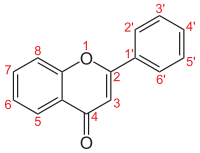
Photo from wikipedia
Flavonoid consumption has reported health benefits such as reducing cardiovascular disease risk factors, improving endothelial function, and delaying age-related cognitive decline. However, there are little dietary intake data for Australians,… Click to show full abstract
Flavonoid consumption has reported health benefits such as reducing cardiovascular disease risk factors, improving endothelial function, and delaying age-related cognitive decline. However, there are little dietary intake data for Australians, which limit our ability to make dietary recommendations to increase intakes to a level where health benefits are seen. The aim of this cross-sectional study was to determine the intake of flavonoids, flavonoid classes, and flavonoid subclasses of 1183 Australians aged 39 to 65 years using a validated 215-item food frequency questionnaire. Based on limited global flavonoid intake data, flavanols are the major dietary flavonoid and are found predominantly in tea and cocoa. As Australians are large tea drinkers, we anticipated that flavanols would be the major flavonoid in the Australian diet. The flavonoid content of foods was determined using a combination of the United States Department of Agriculture Databases and the Phenol-Explorer Database. One-way analysis of variance was undertaken to examine differences between flavonoid intake between men and women. Total flavonoid intake was 626 ± 579 mg/d. Men and women consumed 566 ± 559 mg and 660 ± 588 mg of total flavonoids per day, respectively. Thearubigin accounted for 58% of the flavonoid intake. Women consumed more total flavonoids, thearubigins (both P < .01), anthocyanidins (P < .0001), flavan-3-ols, flavones, and flavonols (all P < .05) than men, whereas men consumed more flavanones than women (P = .01). There was no difference between sexes for the consumption of isoflavones. The data indicated that flavan-3-ols, predominantly thearubigin from tea, were the main flavonoid consumed by Australians. This information contributes to population flavonoid intakes, which should be considered when exploring flavonoid and health relationships.
Journal Title: Nutrition research
Year Published: 2019
Link to full text (if available)
Share on Social Media: Sign Up to like & get
recommendations!